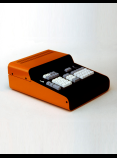How to Reduce Technological Dependence

Allende’s government furthered the import substitution industrialisation model with the goal of achieving higher economic autonomy for Chile in order to benefit social welfare. The nationalisation and rationalisation of goods was intensified. Industrial specialisation for selective manufacturing sought to lower the number of models of widely used goods and sustain the demand via income redistribution.
With these goals in mind, in 1971 the State Development Corporation (CORFO) created the Industrial Design Area of the Technology Research Committee of Chile (INTEC), which implemented the first public policies and state-wide industrial design projects for capital goods and durable consumer goods.
Designers and engineers from the University of Chile, the Pontifical Catholic University of Chile and abroad —led by Gui Bonsiepe from Germany— developed more than twenty pilot projects for state institutions. They focused on agriculture and metalworking, household appliances and basic equipment for kindergartens, homes and health, and the Cybersyn operations room, among others, in addition to graphic design initiatives.
Design joined what was called back then the ‘battle of production’, standardising and homogenising processes and products through socialist manufacturing dynamics, an alternative to capitalism’s system of planned obsolescence. Within this context, the state also promoted economic products such as the IRT’s Antú TV and the Yagán car by the public-private company CORFO-Citroën, which was easy to manufacture by folding sheet metal.

